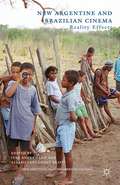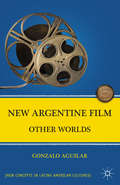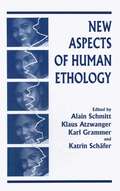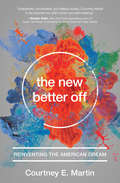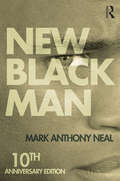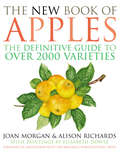- Table View
- List View
The New Arab Man: Emergent Masculinities, Technologies, and Islam in the Middle East
by Marcia C. InhornMiddle Eastern Muslim men have been widely vilified as terrorists, religious zealots, and brutal oppressors of women. The New Arab Man challenges these stereotypes with the stories of ordinary Middle Eastern men as they struggle to overcome infertility and childlessness through assisted reproduction. Drawing on two decades of ethnographic research across the Middle East with hundreds of men from a variety of social and religious backgrounds, Marcia Inhorn shows how the new Arab man is self-consciously rethinking the patriarchal masculinity of his forefathers and unseating received wisdoms. This is especially true in childless Middle Eastern marriages where, contrary to popular belief, infertility is more common among men than women. Inhorn captures the marital, moral, and material commitments of couples undergoing assisted reproduction, revealing how new technologies are transforming their lives and religious sensibilities. And she looks at the changing manhood of husbands who undertake transnational "egg quests"--set against the backdrop of war and economic uncertainty--out of devotion to the infertile wives they love. Trenchant and emotionally gripping, The New Arab Man traces the emergence of new masculinities in the Middle East in the era of biotechnology.
The New Arab Man: Emergent Masculinities, Technologies, and Islam in the Middle East
by Marcia C. InhornMiddle Eastern Muslim men have been widely vilified as terrorists, religious zealots, and brutal oppressors of women. The New Arab Man challenges these stereotypes with the stories of ordinary Middle Eastern men as they struggle to overcome infertility and childlessness through assisted reproduction. Drawing on two decades of ethnographic research across the Middle East with hundreds of men from a variety of social and religious backgrounds, Marcia Inhorn shows how the new Arab man is self-consciously rethinking the patriarchal masculinity of his forefathers and unseating received wisdoms. This is especially true in childless Middle Eastern marriages where, contrary to popular belief, infertility is more common among men than women. Inhorn captures the marital, moral, and material commitments of couples undergoing assisted reproduction, revealing how new technologies are transforming their lives and religious sensibilities. And she looks at the changing manhood of husbands who undertake transnational "egg quests"--set against the backdrop of war and economic uncertainty--out of devotion to the infertile wives they love. Trenchant and emotionally gripping, The New Arab Man traces the emergence of new masculinities in the Middle East in the era of biotechnology.
New Argentine and Brazilian Cinema: Reality Effects (New Directions in Latino American Cultures)
by Jens Andermann and Álvaro Fernández BravoReality Effects brings together the reflections of leading film scholars and critics from Latin America, the UK and the United States on the re-emergence of the real as a prime concern in contemporary Argentine and Brazilian film, and as a main reason for the acclaim both cinematographies have won among international audiences in recent years.
New Argentine Film: Other Worlds (New Directions in Latino American Cultures)
by G. AguilarRespected film critic Gonzalo Aguilar offers a lucid and sophisticated analysis of Argentine films of the last decade. This is the most complete and up-to-date work in English to examine the "new Argentine cinema" phenomenon. Aguilar looks at highly relevant films, including recent award-winners at all of the major festivals.
The New Arrival: Learning To Trust Yourself And Enjoy Your Baby In The First Year Of Your New Life
by Sarah Beeson‘I hadn’t been in Hackney for 24 hours but I knew that the way I saw life and people had changed forever. There was such goodness here but there was a sadness I had never imagined before, and it wasn’t even lunchtime yet …’
The New Art History: A Critical Introduction
by Jonathan HarrisThe New Art History provides a comprehensive introduction to the fundamental changes which have occurred in both the institutions and practice of art history over the last thirty years. Jonathan Harris examines and accounts for the new approaches to the study of art which have been grouped loosely under the term 'the new art history'. He distinguishes between these and earlier forms of 'radical' or 'critical' analysis, explores the influence of other disciplines and traditions on art history, and relates art historical ideas and values to social change. Structured around an examination of key texts by major contemporary critics, including Tim Clarke, Griselda Pollock, Fred Orton, Albert Boime, Alan Wallach and Laura Mulvey, each chapter discusses a key moment in the discipline of art history, tracing the development and interaction of Marxist, feminist and psychoanalytic critical theories. Individual chapters include: * Capitalist Modernity, the Nation-State and Visual Representation * Feminism, Art, and Art History * Subjects, Identities and Visual Ideology * Structures and Meanings in Art and Society * The Representation of Sexuality
The New Art History: A Critical Introduction
by Jonathan HarrisThe New Art History provides a comprehensive introduction to the fundamental changes which have occurred in both the institutions and practice of art history over the last thirty years. Jonathan Harris examines and accounts for the new approaches to the study of art which have been grouped loosely under the term 'the new art history'. He distinguishes between these and earlier forms of 'radical' or 'critical' analysis, explores the influence of other disciplines and traditions on art history, and relates art historical ideas and values to social change. Structured around an examination of key texts by major contemporary critics, including Tim Clarke, Griselda Pollock, Fred Orton, Albert Boime, Alan Wallach and Laura Mulvey, each chapter discusses a key moment in the discipline of art history, tracing the development and interaction of Marxist, feminist and psychoanalytic critical theories. Individual chapters include: * Capitalist Modernity, the Nation-State and Visual Representation * Feminism, Art, and Art History * Subjects, Identities and Visual Ideology * Structures and Meanings in Art and Society * The Representation of Sexuality
New Aspects of Human Ethology
by Alain SchmittRough-and-tumble play provided one of the paradigmatic examples of the appli- tion of ethological methods, back in the 1970's. Since then, a modest number of - searchers have developed our knowledge of this kind of activity, using a variety of methods, and addressing some quite fundamental questions about age changes, sex diff- ences, nature and function of behaviour. In this chapter I will review work on this topic, mentioning particularly the interest in comparing results from different informants and different methods of investigation. Briefly, rough-and-tumble play (or R&T for short) refers to a cluster of behaviours whose core is rough but playful wrestling and tumbling on the ground; and whose general characteristic is that the behaviours seem to be agonistic but in a non-serious, playful c- text. The varieties of R&T, and the detailed differences between rough-and-tumble play and real fighting, will be discussed later. 2. A BRIEF HISTORY OF RESEARCH ON R&T In his pioneering work on human play, Groos (1901) described many kinds of rough-and-tumble play. However, R&T was virtually an ignored topic from then until the late 1960's. There was, of course, a flowering of observational research on children in the 1920s and 1930s, especially in North America; but this research had a strong practical o- entation, and lacked the cross-species perspective and evolutionary orientation present in Groos' work.
The New Australian Military Sociology: Antipodean perspectives (Military Politics #2)
by Brad West Cate CarterCivil-military relations have changed over time with respect to changing demographics, new domestic and international responsibilities, Industry-Defence cooperation, women in the armed forces and contemporary veteran wellbeing.The New Australian Military Sociology aims to provide an antipodean view to theorising civil-military entanglements and uses Australia’s unique geographic, political and cultural context to serve as a case study for other countries.
The New Australian Military Sociology: Antipodean perspectives (Military Politics #2)
by Brad West Cate CarterCivil-military relations have changed over time with respect to changing demographics, new domestic and international responsibilities, Industry-Defence cooperation, women in the armed forces and contemporary veteran wellbeing.The New Australian Military Sociology aims to provide an antipodean view to theorising civil-military entanglements and uses Australia’s unique geographic, political and cultural context to serve as a case study for other countries.
The New Australian Military Sociology: Antipodean perspectives (Military Politics #2)
by Brad West Cate CarterCivil-military relations have changed over time with respect to changing demographics, new domestic and international responsibilities, Industry-Defence cooperation, women in the armed forces and contemporary veteran wellbeing.The New Australian Military Sociology aims to provide an antipodean view to theorising civil-military entanglements and uses Australia’s unique geographic, political and cultural context to serve as a case study for other countries.
New Babylon New Nineveh
by Charles Von OnselenAvailable again in a single volume, New Babylon, New Nineveh explores the past struggles of everyday people on the Witwatersrand, South Africa, 1886-1914. This was a period of extraordinary social, political and economic change. Charles van Onselen examines a host of practices, processes and problems which, in many ways, make for startling comparisons with modern-day South Africa. Van Onselen investigates the pervasive, but highly problematic use of alcohol and prostitution, which were used to control both black and white mine workers, by the state and the mine owners. This exploitation of the lifestyle of the single miners later gave way to the official encouragement of working-class family life. This gave rise to the advent of domestic servants and the introduction of a systematic programme of suburbanisation and cheap public transportation. We see how not even these developments were able to protect the poorest and weakest South Africans of the time. Van Onselen explains how Afrikaner unemployment and an affinity for trade unionism were paralleled by further marginalisation, black unemployment and the resultant formation of prison gangs, which flourish even to the present day.
The New Better Off: Reinventing the American Dream
by Courtney E. MartinAre we living the good life-and what defines 'good', anyway? Americans today are constructing a completely different framework for success than their parents' generation, using new metrics that TEDWomen speaker and columnist Courtney Martin has termed collectively the "New Better Off". The New Better Off puts a name to the American phenomenon of rejecting the traditional dream of a 9-to-5 job, home ownership, and a nuclear family structure-illuminating the alternate ways Americans are seeking happiness and success.Including commentary on recent changes in how we view work, customs and community, marriage, rituals, money, living arrangements, and spirituality, The New Better Off uses personal stories and social analysis to explore the trends shaping our country today. Martin covers growing topics such as freelancing, collaborative consumption, communal living, and the breaking down of gender roles. The New Better Off is about the creative choices individuals are making in their vocational and personal lives, but it’s also about the movements, formal and informal, that are coalescing around the New Better Off idea-people who are reinventing the social safety net and figuring out how to truly better their own communities.
The New Biology: Law, Ethics, and Biotechnology
by George P. Smith IIImprovement of man's genetic endowment by direct ac tions aimed at striving for the positive propagation of those with a superior genetic profile (an element of which is commonly recognized as a high intelligence quotient) or-conversely-delimitation of those with negative genetic inheritance has always remained a pri mary concern of the geneticist and the social engineer. Genetic integrity, eugenic advancement, and a strong genetic pool designed to eliminate illness and suffering have been the benchmarks of the "Genetic Movement" and the challenge of Orwell's Nineteen Eighty-Four. If the quality of life can in some way be either im proved or advanced by use of the law, then this policy must be developed and pursued. No longer does the Dostoyevskian quest to give life meaning through suf fering become an inescapable given. By and through the development and application of new scientific advances in the field of genetics (and especially genetic engi neering), the real potential exists to prevent, to a very vii Preface viii real extent, most human suffering before it ever mani fests itself in or through life. Freedom to undertake re search in the exciting and fertile frontiers of the "New Biology" and to master the Genetic Code must be nur tured and maintained. The search for the truth inevi tably prevents intellectual, social, and economic stag nation, as well as-ideally-frees all from anxiety and fright. Yet, there is a very real potential for this quest to confuse and confound.
The New Black History: Revisiting the Second Reconstruction (Critical Black Studies)
by E. HintonThe New Black History anthology presents cutting-edge scholarship on key issues that define African American politics, life, and culture, especially during the Civil Rights and Black Power eras. The volume includes articles by both established scholars and a rising generation of young scholars.
New Black Man: Tenth Anniversary Edition
by Mark Anthony NealTen years ago, Mark Anthony Neal’s New Black Man put forth a revolutionary model of Black masculinity for the twenty-first century—one that moved beyond patriarchy to embrace feminism and combat homophobia. Now, Neal’s book is more vital than ever, urging us to imagine a New Black Man whose strength resides in family, community, and diversity. Part memoir, part manifesto, this book celebrates the Black man of our times in all his vibrancy and virility. The tenth anniversary edition of this classic text includes a new foreword by Joan Morgan and a new introduction and postscript from Neal, which bring the issues in the book up to the present day.
New Black Man: Tenth Anniversary Edition
by Mark Anthony NealTen years ago, Mark Anthony Neal’s New Black Man put forth a revolutionary model of Black masculinity for the twenty-first century—one that moved beyond patriarchy to embrace feminism and combat homophobia. Now, Neal’s book is more vital than ever, urging us to imagine a New Black Man whose strength resides in family, community, and diversity. Part memoir, part manifesto, this book celebrates the Black man of our times in all his vibrancy and virility. The tenth anniversary edition of this classic text includes a new foreword by Joan Morgan and a new introduction and postscript from Neal, which bring the issues in the book up to the present day.
New Body Politics: Narrating Arab and Black Identity in the Contemporary United States (Routledge Series on Identity Politics)
by Therí A. PickensIn the increasingly multi-racial and multi-ethnic American landscape of the present, understanding and bridging dynamic cross-cultural conversations about social and political concerns becomes a complicated humanistic project. How do everyday embodied experiences transform from being anecdotal to having social and political significance? What can the experience of corporeality offer social and political discourse? And, how does that discourse change when those bodies belong to Arab Americans and African Americans? Therí A. Pickens discusses a range of literary, cultural, and archival material where narratives emphasize embodied experience to examine how these experiences constitute Arab Americans and African Americans as social and political subjects. Pickens argues that Arab American and African American narratives rely on the body’s fragility, rather than its exceptional strength or emotion, to create urgent social and political critiques. The creators of these narratives find potential in mundane experiences such as breathing, touch, illness, pain, and death. Each chapter in this book focuses on one of these everyday embodied experiences and examines how authors mobilize that fragility to create social and political commentary. Pickens discusses how the authors' focus on quotidian experiences complicates their critiques of the nation state, domestic and international politics, exile, cultural mores, and the medical establishment. New Body Politics participates in a vibrant interdisciplinary conversation about cross-ethnic studies, American literature, and Arab American literature. Using intercultural analysis, Pickens explores issues of the body and representation that will be relevant to fields as varied as Political Science, African American Studies, Arab American Studies, and Disability Studies.
New Body Politics: Narrating Arab and Black Identity in the Contemporary United States (Routledge Series on Identity Politics)
by Therí A. PickensIn the increasingly multi-racial and multi-ethnic American landscape of the present, understanding and bridging dynamic cross-cultural conversations about social and political concerns becomes a complicated humanistic project. How do everyday embodied experiences transform from being anecdotal to having social and political significance? What can the experience of corporeality offer social and political discourse? And, how does that discourse change when those bodies belong to Arab Americans and African Americans? Therí A. Pickens discusses a range of literary, cultural, and archival material where narratives emphasize embodied experience to examine how these experiences constitute Arab Americans and African Americans as social and political subjects. Pickens argues that Arab American and African American narratives rely on the body’s fragility, rather than its exceptional strength or emotion, to create urgent social and political critiques. The creators of these narratives find potential in mundane experiences such as breathing, touch, illness, pain, and death. Each chapter in this book focuses on one of these everyday embodied experiences and examines how authors mobilize that fragility to create social and political commentary. Pickens discusses how the authors' focus on quotidian experiences complicates their critiques of the nation state, domestic and international politics, exile, cultural mores, and the medical establishment. New Body Politics participates in a vibrant interdisciplinary conversation about cross-ethnic studies, American literature, and Arab American literature. Using intercultural analysis, Pickens explores issues of the body and representation that will be relevant to fields as varied as Political Science, African American Studies, Arab American Studies, and Disability Studies.
The New Book of Apples: The Definitive Guide To Over 2000 Varieties
by Joan MorganThis extraordinary book contains in one unique volume, the most wide-ranging history of apples ever written and a detailed survey of over 2,000 of the world's apple varieties. Beautifully illustrated with 32 exquisite colour paintings, the last edition of this book received many accolades and was quickly recognised as a classic. Complete with a fully revised directory covering all the varieties of apple to be found in the world's largest apple collection, The New Book of Apples includes full historical, geographical and botanical details as well as tasting notes on each type of apple. Exploring the role of apples in cooking, cider making, gardening, myth and medicine, this is an indispensable reference guide.
New Border and Citizenship Politics (Migration, Diasporas and Citizenship)
by Helen Schwenken Sabine Ru�-SattarThis collection examines the intersections and dynamics of bordering processes and citizenship politics in the Global North and Australia. By taking the political agency of migrants into account, it approaches the subject of borders as a genuine political and socially constructed phenomenon and transcends a state-centered perspective.
New Borders: Hotspots and the European Migration Regime (Radical Geography)
by Joe Painter Antonis Vradis Evie Papada Anna PapoutsiTo many, a border is a geographical fact. But what happens when a border is subject to an emergency? Today, as millions are forced to migrate due to war, famine and political unrest, it is important to analyse how states use new bordering techniques to control populations.*BR**BR*New Borders focuses on the Greek island of Lesbos. Since 2015, the island has come under intense scrutiny as more than one million people have disembarked on its shores.*BR**BR*During this time, the authors spent two years studying the changing meanings and functions of the EU's border. They observed how the reception of the refugees slid into detention and refuge became duress. Examining how and why this happened, they tackle questions on European policy, the securitisation of national and EU borders and the real impacts this has had on everyday life, determining who 'belongs' where and when.
New Borders: Hotspots and the European Migration Regime (Radical Geography)
by Antonis Vradis Evie Papada Joe Painter Anna PapoutsiTo many, a border is a geographical fact. But what happens when a border is subject to an emergency? Today, as millions are forced to migrate due to war, famine and political unrest, it is important to analyse how states use new bordering techniques to control populations.*BR**BR*New Borders focuses on the Greek island of Lesbos. Since 2015, the island has come under intense scrutiny as more than one million people have disembarked on its shores.*BR**BR*During this time, the authors spent two years studying the changing meanings and functions of the EU's border. They observed how the reception of the refugees slid into detention and refuge became duress. Examining how and why this happened, they tackle questions on European policy, the securitisation of national and EU borders and the real impacts this has had on everyday life, determining who 'belongs' where and when.
The New Bosnian Mosaic: Identities, Memories and Moral Claims in a Post-War Society
by Elissa HelmsSince the violent events of the Bosnian war and the revelations of ethnic cleansing that shocked the world in the early 1990s, Bosnia has become a metaphor for the new ethnic nationalisms, for the transformation of warfare in the post-Cold War era, and for new forms of peacekeeping and state-building. This book is unique in offering a re-examination of the Bosnian case with a 'bottom-up' perspective. It gathers together cultural anthropologists and other social scientists to consider the specificities of the Bosnian case. However, the book also raises broader questions: what are the consequences of internecine violence and how should societies attempt to overcome them? Are the uncertainties and the transformations of Bosnian post-war society due entirely to the war, or are they related to wider processes encompassing post-communist Europe as a whole? And are the difficulties experienced by international state-building operations mainly due to distinctive features of the local societies or are they due to the policies promoted by the international community itself?
The New Bosnian Mosaic: Identities, Memories and Moral Claims in a Post-War Society
by Elissa HelmsSince the violent events of the Bosnian war and the revelations of ethnic cleansing that shocked the world in the early 1990s, Bosnia has become a metaphor for the new ethnic nationalisms, for the transformation of warfare in the post-Cold War era, and for new forms of peacekeeping and state-building. This book is unique in offering a re-examination of the Bosnian case with a 'bottom-up' perspective. It gathers together cultural anthropologists and other social scientists to consider the specificities of the Bosnian case. However, the book also raises broader questions: what are the consequences of internecine violence and how should societies attempt to overcome them? Are the uncertainties and the transformations of Bosnian post-war society due entirely to the war, or are they related to wider processes encompassing post-communist Europe as a whole? And are the difficulties experienced by international state-building operations mainly due to distinctive features of the local societies or are they due to the policies promoted by the international community itself?

